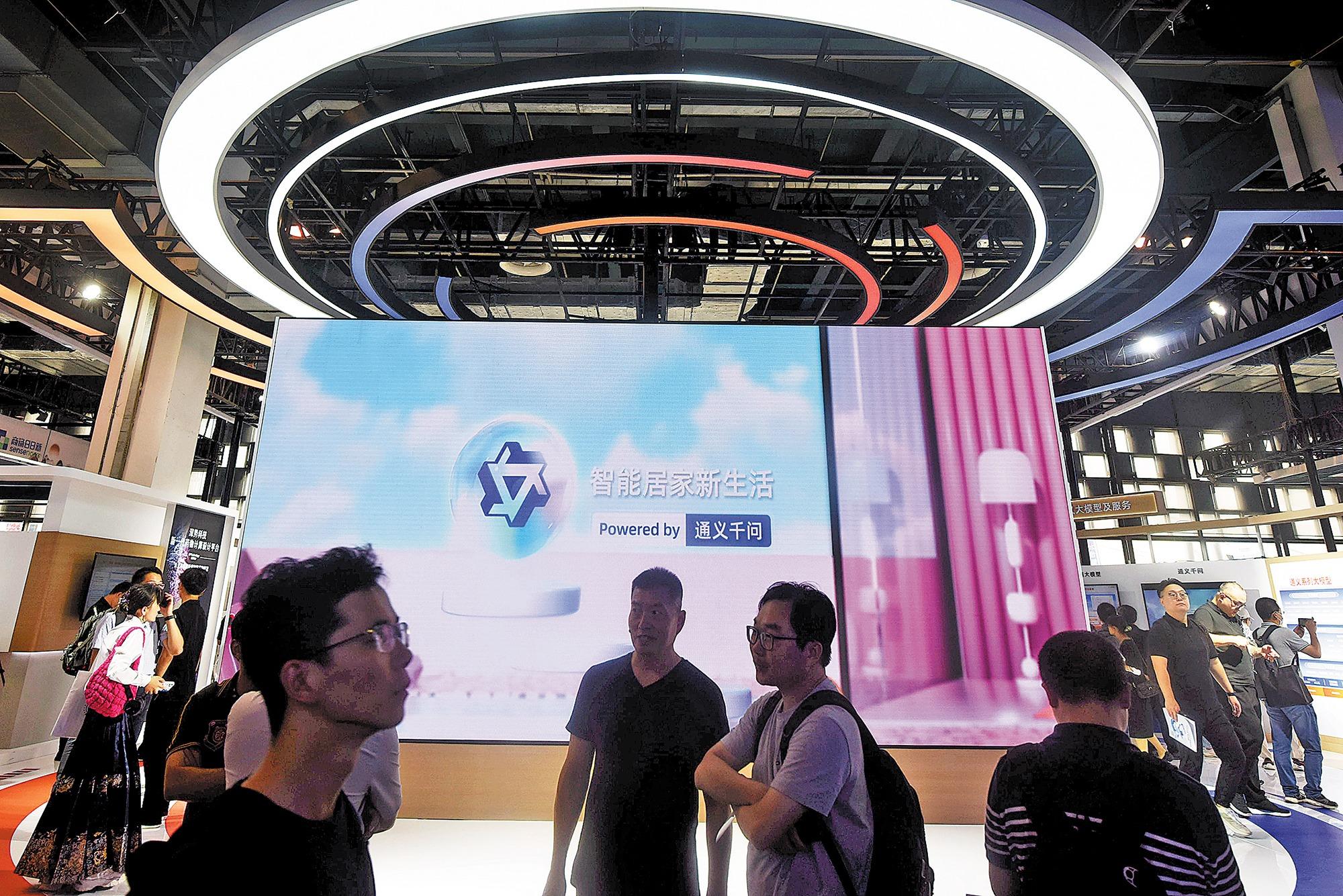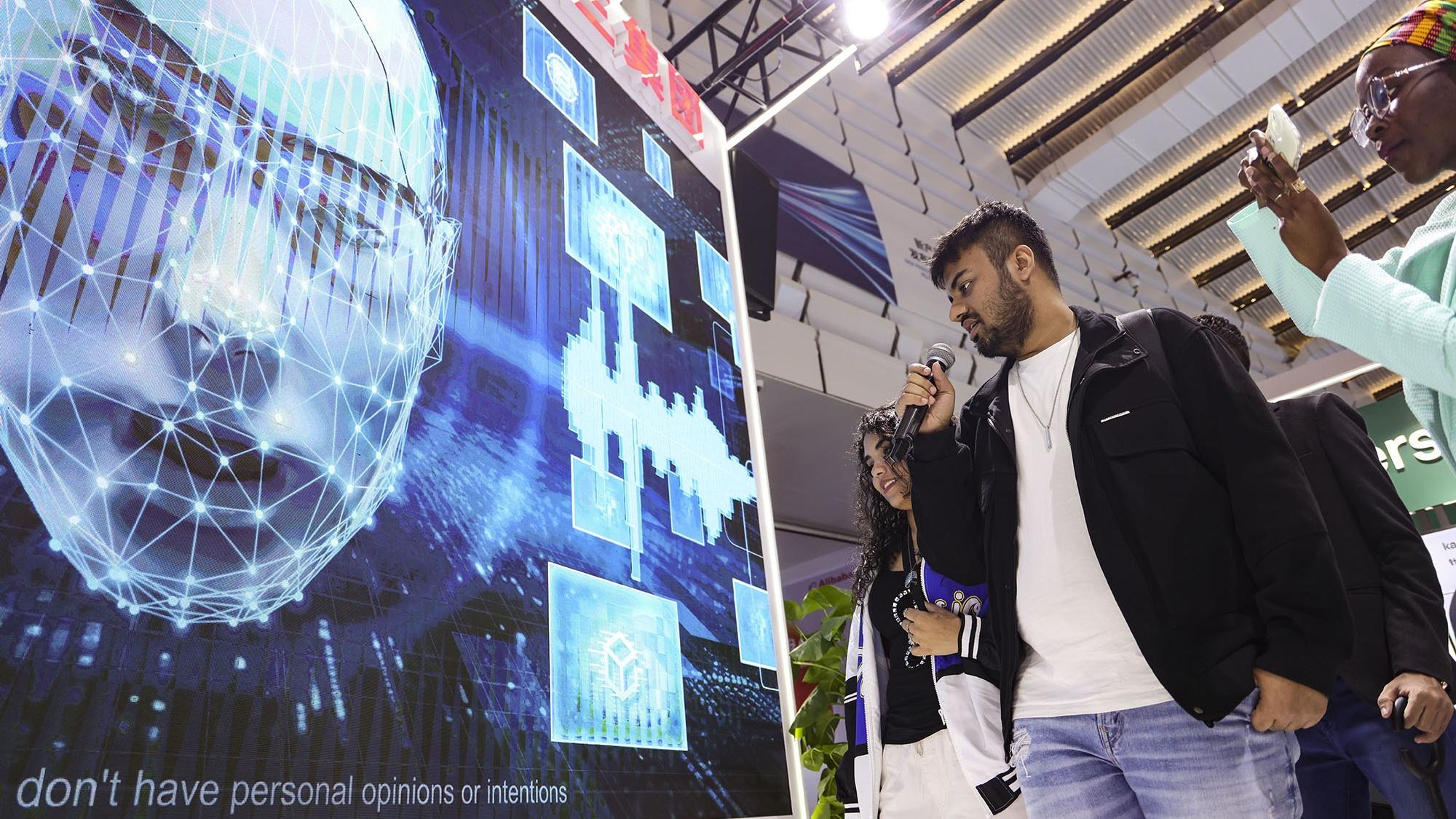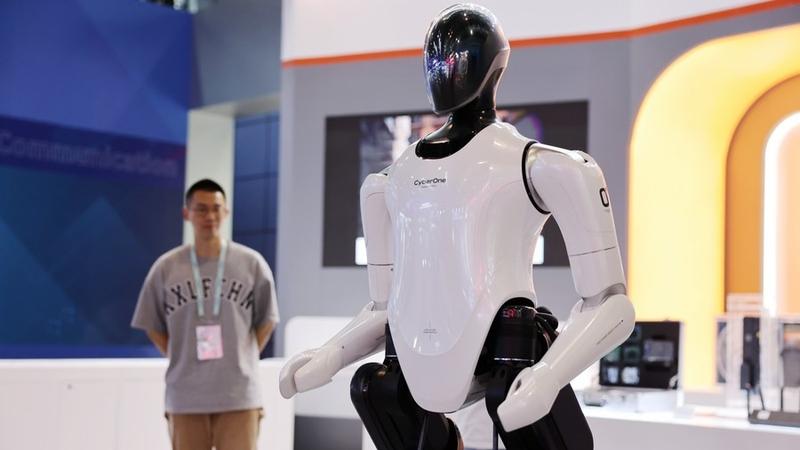 (SHI YU / CHINA DAILY)
(SHI YU / CHINA DAILY)
AI "anxiety" swept across netizens and industries in China last month, when OpenAI, the United States company that developed the artificial intelligence-powered language model ChatGPT, launched Sora — a text-to-video model that allows users to create photorealistic videos based on prompts they've written.
Why weren't groundbreaking technologies such as Sora and ChatGPT created in China? How long will it be before China's equivalent of Sora comes out? Is the AI gap between China and the US widening? These were typical of some of the questions being asked across the nation.
While some people in China are concerned about falling behind the US in frontier AI technologies, leading company executives and experts believe that China's AI large model - a type of AI algorithm that uses deep learning and data sets to understand, summarize, generate and predict new content - has developed quicker than expected and has unique advantages over its US counterpart.
They did concede, however, that more joint efforts are needed to develop underlying AI technologies such as GPT-4 as well as computing power to close the gap with the US.
Zhou Chengxiong, a researcher from the Institutes of Science and Development of the Chinese Academy of Sciences, said while most of the current breakthroughs in AI technology are emerging from US companies, latecomers also have advantages. For instance, they have fewer risks and uncertainties during the progress in development
"There is no need to be overly anxious about the launch of Sora," said Liu Qingfeng, chairman of Chinese AI company iFlytek Co Ltd. "Sora is just a successful implementation of basic capabilities of GPT-4 in the video sector, in other words, the underlying competitiveness of such tech still lies in GPT-4."
Liu, who is also a deputy to the 14th National People's Congress, the nation's top legislature, said that the main focus of the current AI competition between the US and China is still over the capability of the base of the AI large model. "In terms of such a foundation, Chinese companies have the confidence to develop it quite well. It is impossible for the country to be left with a huge gap to the US in AI development," he said.
Zhou Chengxiong, a researcher from the Institutes of Science and Development of the Chinese Academy of Sciences, said while most of the current breakthroughs in AI technology are emerging from US companies, latecomers also have advantages. For instance, they have fewer risks and uncertainties during the progress in development.
"In addition, Chinese companies have developed AI large models and related technologies in a profitable way over the past year and have already accumulated basic infrastructure and technologies needed to develop the equivalent of Sora and ChatGPT," Zhou said.
He added that, "China still has a huge opportunity to be at the forefront of the world in the application of AI technologies in the future."
Steady progress
As of October, China had developed 254 AI large models with a parameter of at least a billion tokens each, according to a report released by the Beijing Municipal Science &Technology Commission. Tokens are chunks of text that AI learns from, while a parameter is used for evaluating numeric data.
From December to February, more than 10 A-share companies, including Wondershare, BroadV, Eclicktech and Hanvon Technology disclosed their investment and progress made in their text-to-video models.
Well aware of the opportunities, Chinese tech companies such as Alibaba Group, Tencent Holdings, Baidu Inc, ByteDance and Huawei Technologies as well as thousands of startups are scrambling to develop AI large models. Many of them have gained momentum over the past year.
Liu's iFlytek, based in Hefei, Anhui province, unveiled its SparkDesk AI large model in May. The company said in January that its upgraded version outperformed GPT-4 Turbo — the latest generation of ChatGPT — in metrics including language understanding and math.
 Alibaba’s AI-powered large language model Tongyi Qianwen is presented during the World Artificial Intelligence Conference in Shanghai in July 2023. (LONG WEI / FOR CHINA DAILY)
Alibaba’s AI-powered large language model Tongyi Qianwen is presented during the World Artificial Intelligence Conference in Shanghai in July 2023. (LONG WEI / FOR CHINA DAILY)
Its capability in multimodal understanding had reached 91 percent of that of OpenAI's most advanced model. The company said that SparkDesk is expected to reach the level of GPT-4 Turbo "in an all-around way" in the first half of this year.
Liu said Huawei founder Ren Zhengfei had sent the company's highest-level team to Hefei to work on co-development of the model.
"Through continuous optimization of software and hardware like chips, the training efficiency has increased from 20 to 30 percent to the current 90 percent," Liu said of the advances made in Spark-Desk's development.
China focuses more on applications, and those launching these startups are better at adapting technology to various industries, and commercializing different applications. Chinese companies are also more flexible in creating personalized products and innovations.
Zhou Yu, chairman of Beijing Fanyu Technology Co, a startup specializing in natural language processing products and services
Domestic tech giant Tencent Holdings debuted its AI large model, Hunyuan, in September. Hunyuan has so far been connected to more than 50 of Tencent's products and services, such as WeChat search, cloud, advertising, gaming, financial technology, online meetings and documents.
In June, Tencent Cloud, the company's cloud subsidiary, also launched an industry-specific large model. Compared with general large models like ChatGPT, industry-specific large models are industrial versions of ChatGPT focused on niche sectors.
Landmark year
Zhou Hongyi, founder and chairman of 360 Security Technology and a member of the 14th National Committee of the Chinese People's Political Consultative Conference, the country's top political advisory body, said that 2024 should be the "year of application" for Chinese AI development.
"China can follow a development path of large models with Chinese characteristics that will support the development of large models in the direction of vertical sectors and industrialization to help accelerate the formation of new quality productive forces," he said.
Compared with traditional productive tools that are driven by factors such as labor, land and capital, new quality productive forces refer to technological innovation, data and smart or intelligent technologies.
"Developing a universal large model that surpasses GPT-4 in an all-around way may be challenging at the moment, but GPT-4 currently knows everything, yet (it is) not specialized," he explained.
"If we can excel in a particular business domain by training a large model with unique business data — and integrate it with many business tools within that vertical — such a large model will not only have intelligence but also possess unique knowledge," he said. "It is entirely possible for China to surpass its US counterparts in a year or two."
Zhou Yu, chairman of Beijing Fanyu Technology Co, a startup specializing in natural language processing products and services, said Chinese and US startups appear to be adopting different approaches to developing large models that drive generative AI.
"The US puts more emphasis on the research and development of underlying technology and groundbreaking innovations. The US is a world leader in terms of hardware and deep-learning frameworks," Zhou said.
 Visitors check out an AI-powered large language model during an internet expo in Wuzhen, Zhejiang province, in November 2023. (YAO YINGKANG / FOR CHINA DAILY)
Visitors check out an AI-powered large language model during an internet expo in Wuzhen, Zhejiang province, in November 2023. (YAO YINGKANG / FOR CHINA DAILY)
"China focuses more on applications, and those launching these startups are better at adapting technology to various industries, and commercializing different applications. Chinese companies are also more flexible in creating personalized products and innovations," she added.
Zhou Hongyi from 360 Security Technology suggested at the two sessions in Beijing earlier this month that the government and State-owned enterprises take the lead in opening up more application development scenarios, so that large models can drive the digitalization of enterprises and various industries.
Wang Peng, a researcher at the Beijing Academy of Social Sciences, said intensified and joint efforts by the central government, local governments and companies will create more opportunities for China
The Government Work Report released at the two sessions said China will step up research and development, applications of big data and AI, launch an AI Plus initiative, and build internationally competitive digital industry clusters.
The country will also strive to modernize its industrial system and develop new quality productive forces at a faster pace, give full rein to the leading role of innovation, spur industrial innovation through innovations in science and technology, and press ahead with new industrialization, according to the report.
Regional role
Several provincial-level regions across China identified new quality productive forces like AI as their top priorities at meetings in February, where they released their blueprint and action plans for 2024.
Huang Kunming, Party chief of Guangdong province, said that as a pacesetter, Guangdong should take the lead in reaching the level of a moderately developed and innovative economy by 2035.
But, he added, there are still large gaps and deficiencies. The key to achieving these goals is technological innovation, industrial development, and the continuous unleashing and development of new quality productive forces such as AI.
Wang Peng, a researcher at the Beijing Academy of Social Sciences, said intensified and joint efforts by the central government, local governments and companies will create more opportunities for China.
He noted that China unveiled a new-generation AI development plan back in 2017. This helped the country accumulate technical reserves and organize teams in the field of cognitive intelligence, making China an important player in the global AI arena.
"Now, AI has been put even higher on the agenda. It is entirely possible for China to leverage existing resources to gain a lead in AI development in the new round of global technological competition," he said.
 This photo taken on May 26, 2023 shows a full-size humanoid bionic robot displayed at the exhibition center of Zhongguancun National Independent Innovation Demonstration Zone in Beijing, capital of China. (PHOTO / XINHUA)
This photo taken on May 26, 2023 shows a full-size humanoid bionic robot displayed at the exhibition center of Zhongguancun National Independent Innovation Demonstration Zone in Beijing, capital of China. (PHOTO / XINHUA)
Smarter approach
Though China has quickly developed AI large models and related areas, Wu Hequan, an academician at the Chinese Academy of Engineering, said that greater efforts are needed to close the gaps in computing power and key underlying technologies.
China aims to boost its aggregate computing power by more than 30 percent by 2025. The nation's computing power last year touched 197 Eflops — a measure of the performance of a supercomputer — and it ranked second globally behind the US, Ministry of Industry and Information Technology data showed
AI large model training requires a huge amount of computation, he said, so expanding the supply of computing power has become increasingly important in the global race for AI leadership.
As the US continues to restrict exports to China of high-end processors, such efforts are more urgent than ever.
China aims to boost its aggregate computing power by more than 30 percent by 2025. The nation's computing power last year touched 197 Eflops — a measure of the performance of a supercomputer — and it ranked second globally behind the US, Ministry of Industry and Information Technology data showed.
Wang Xiaochuan, founder of Baichuan AI, has said that OpenAI is currently attempting to connect 10 million graphics processing units. By comparison, China has far less amount of GPUs, an indication that core resources needed in the country's AI development are lacking, Wang said.
Zhang Feng, deputy director of the Institutes of Science and Development of the Chinese Academy of Sciences, pointed out that China also faces security challenges in its development of AI large models.
"More efforts are needed to strengthen the safety evaluation of large model technology, develop security specifications and standards applicable to large models, and conduct security assessments and vulnerability detection on large model data privacy protection," she said.
Zhang said the lack of openness in regard to high-quality data sets was also a problem. "Due to unclear data ownership and sharing specifications, it is difficult to publicly obtain large-scale, high-quality data, which will hinder the collaborative development of AI large model technology and applications," Zhang said.
She added that China should make coordinated efforts to construct large-scale data sets, promote greater openness of high-quality public data, and gradually open up such data to leading companies for their use and further development.



